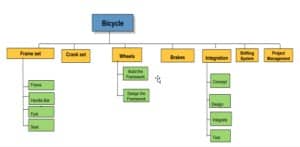Eight Powerful Project Management Processes Part 3: Work Breakdown Structure
/*Eight Powerful Project Management Processes Part 3: Work Breakdown Structure

This is Part Three of our series on the “Eight Powerful Project Management Processes,” a look at the project management processes that we have found in our experiences to be most crucial to project success. Previously, we have examined the project charter and stakeholder analysis; in this post, we take a closer look at the Work Breakdown Structure (WBS). If you are interested in any of these eight processes, we recommend you also look into our upcoming product, Essential Gear for Project Managers Level 1.
The Work Breakdown Structure, or WBS, is another critical component of project management. It is a representation of the scope of the project broken down into several levels so that the project’s deliverables can be identified and assigned. The WBS is a critical project management process because it divides project work into manageable portions and controls scope. If an item doesn’t fit in the WBS, it doesn’t fit in the project.
Beyond its use in managing the project scope and project work, the WBS is critical to many other parts of the project. The WBS creation process facilitates communication among the project team, helps to achieve buy-in for the project work, and helps to manage stakeholder expectations. Time, cost, and even risk planning reference the WBS.
Now that we know why the WBS is so critical, what are some of the best practices associated with creating one?
1. Collaborate and seek input on the WBS.
Collaboration is a key to making sure the scope is adequately defined. If crucial parts of the project are absent from the WBS, they will have to come in later through change control. PMI’s Practice Standard for Work Breakdown Structures (p. 20) defines three key groups to seek input from:
- The people who will be performing the work
- Subject matter experts (SMEs)
- Other stakeholders, including financial and business managers
The people performing the work need input into the WBS so that they understand and accept the work. Subject matter experts and other stakeholders can provide key details to ensure that the work packages are technically and financially feasible and align with business strategy.
2. Create a WBS dictionary.
A WBS dictionary is a supplemental document that provides more information about the work packages in the WBS. This can include ID or control numbers, detailed descriptions, supporting documentation, and a variety of other items. The WBS dictionary is crucial in ensuring that the people performing the work interpret the requirements correctly. The WBS dictionary, along with the WBS and project scope statement, make up the project’s scope baseline.
3. Remember the 100 percent rule
The WBS needs to contain all project work. The way to determine this is making sure that the decomposed child levels of the WBS add up to 100 percent of the parent work. Doing this ensures that the levels match. No work should go unaccounted for, and total work should not exceed 100 percent.
4. Work packages should not exceed 32 hours.
8-32 hours is a good range to follow with WBS work packages, especially for small or medium-sized projects. The key is to make sure that work packages are decomposed enough that the package can be estimated and assigned, risks can be assessed, and performance can be tracked. Decomposing too far can lead to unnecessary reporting and control work. Work packages may be up to a couple hundred hours each on very large projects, but 8-32 hours should work as a guideline for most projects.
What are your best practices with creating a WBS? Please share your thoughts in the comments.
Image adapted from the Practice Standard for Work Breakdown Structures.
Essential Gear for Project Managers is a toolkit with the eight essential project management processes you need to deliver projects on time, on budget, and exceeding expectations. Delivered to you via intuitive templates and a handbook describing best practices and pitfalls.